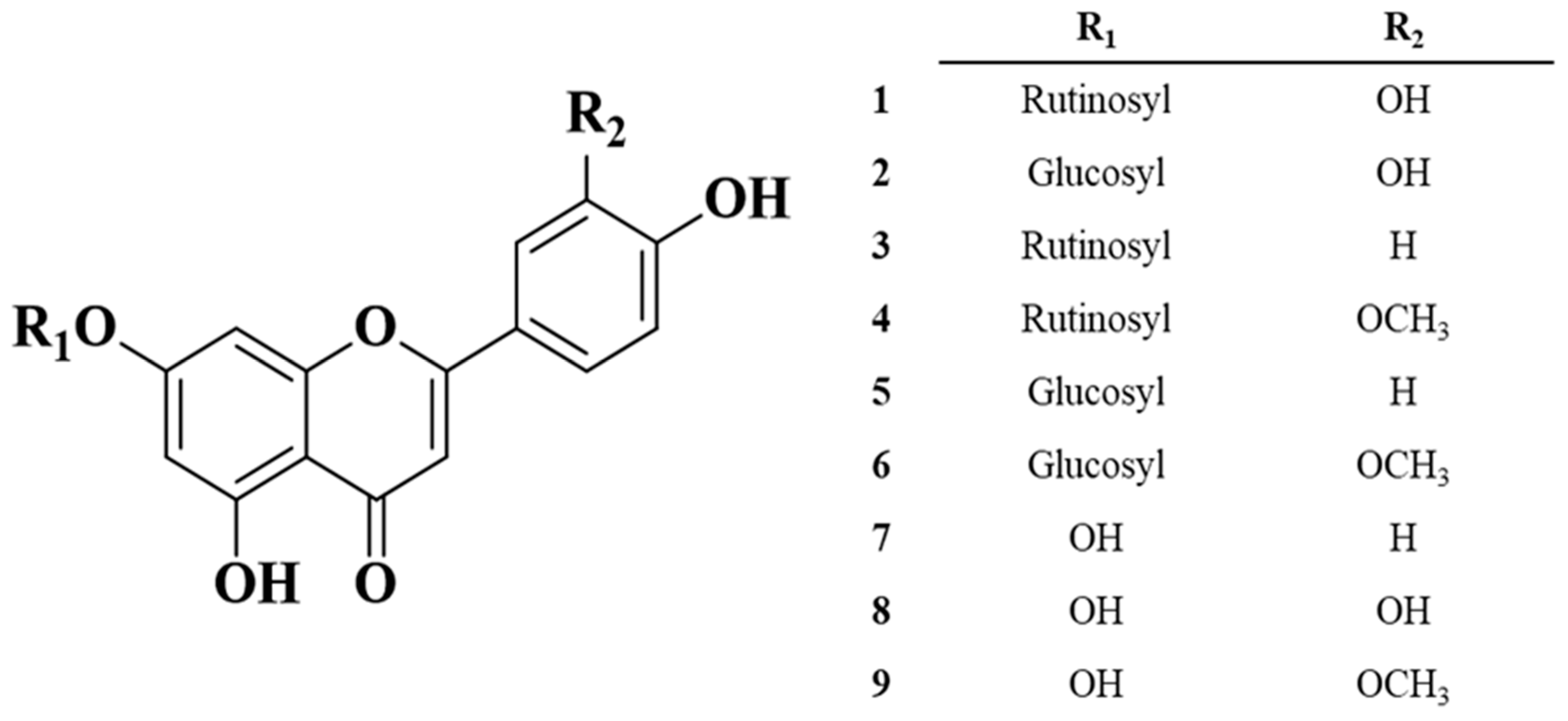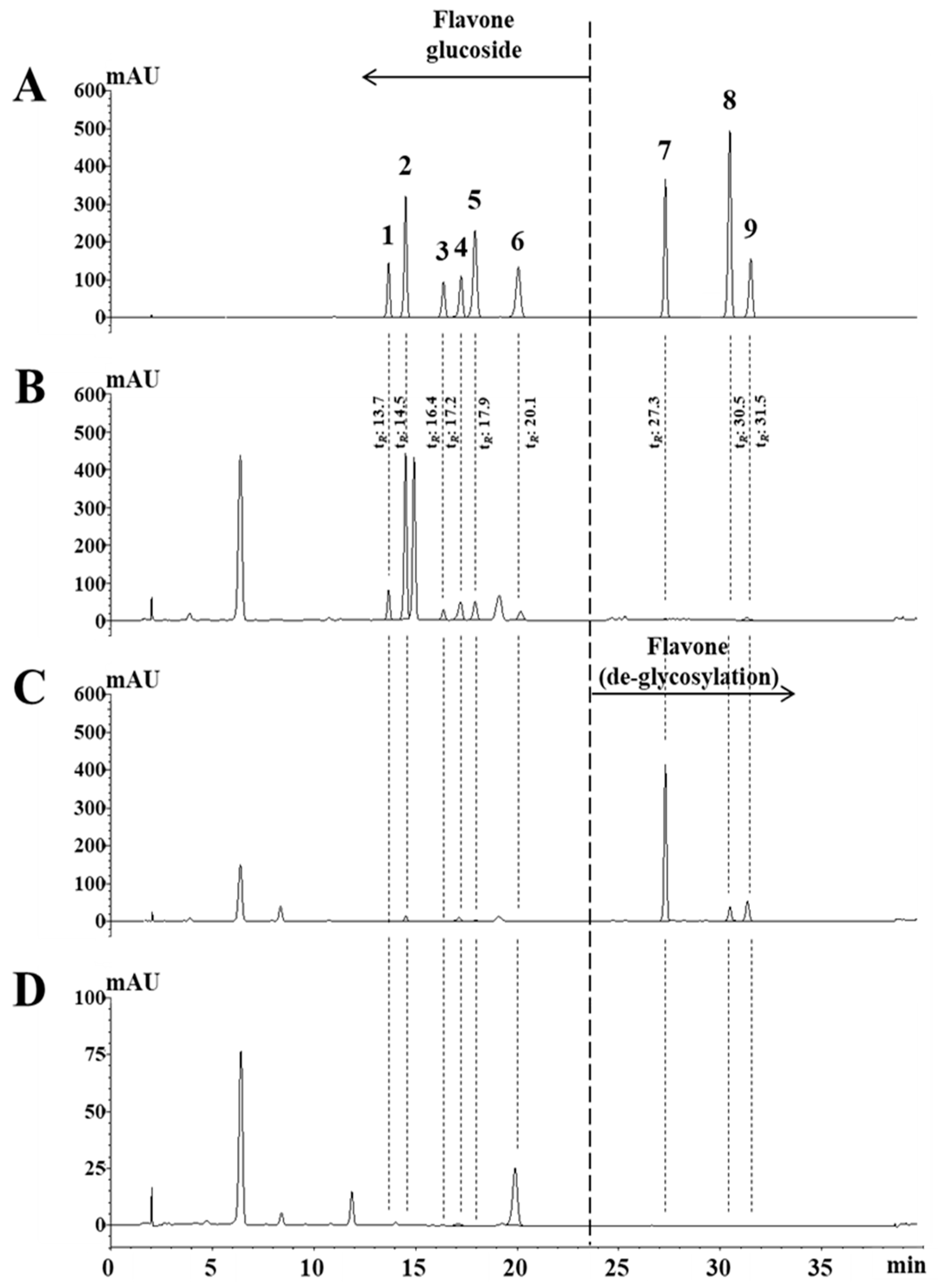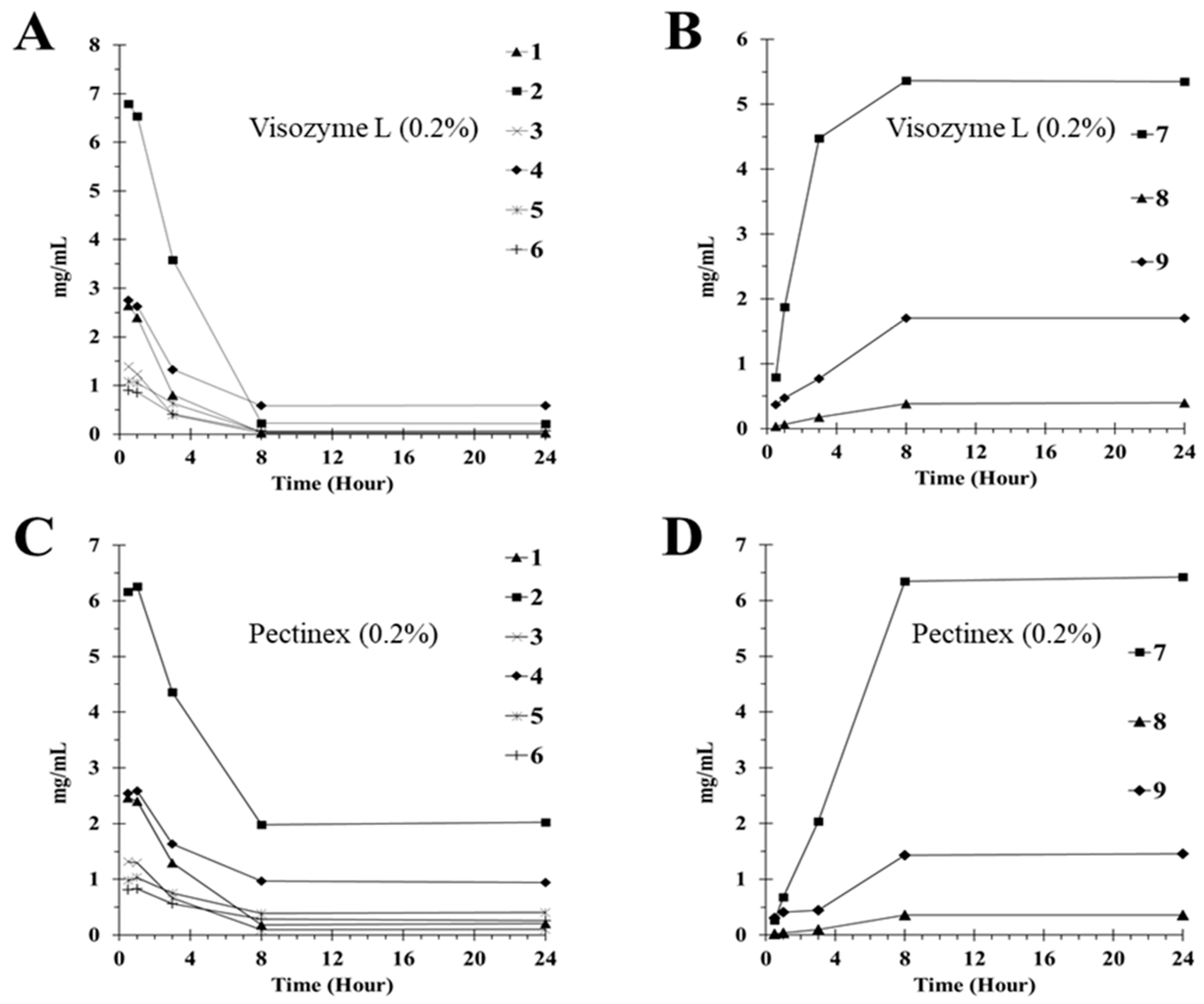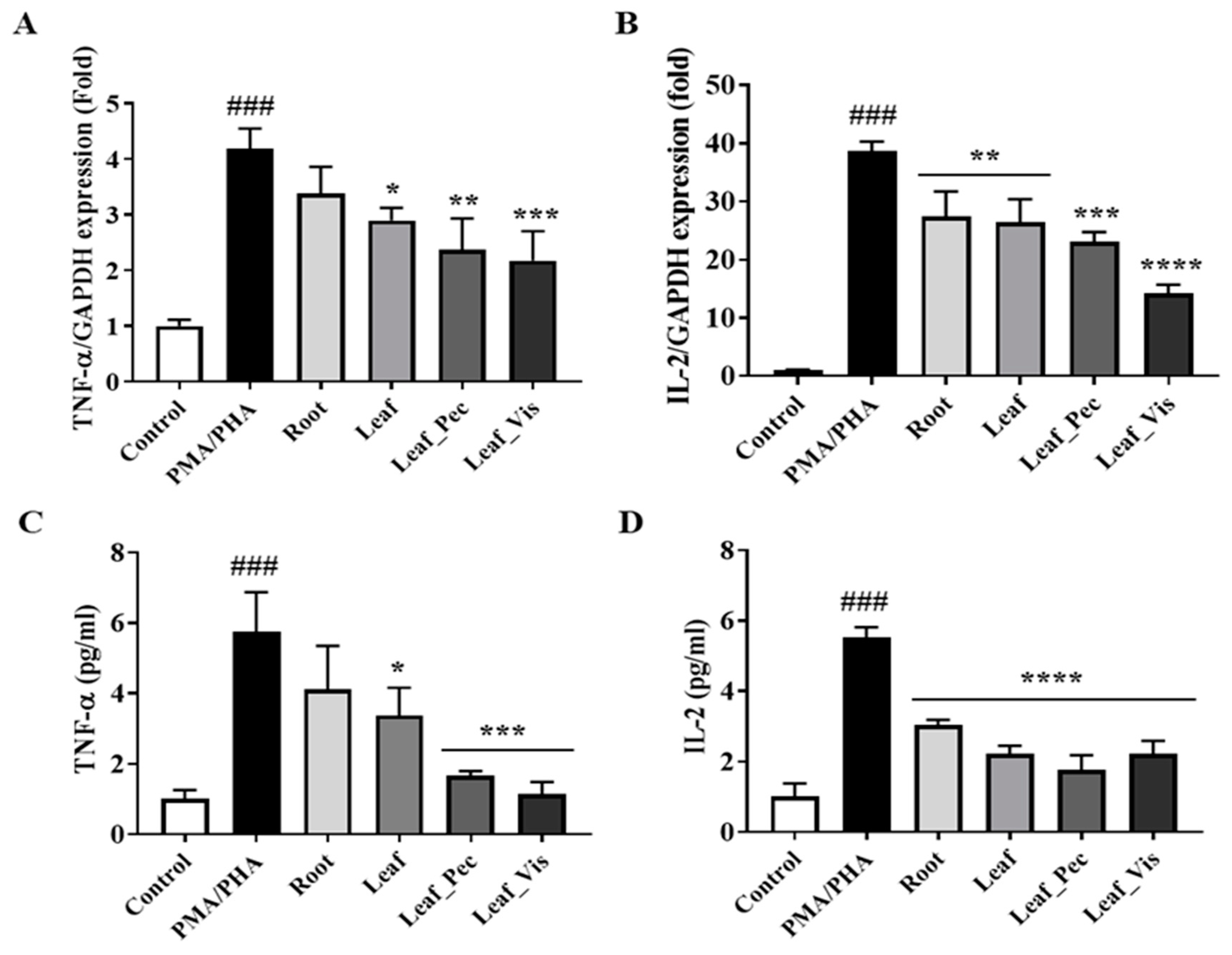Submitted:
21 April 2023
Posted:
21 April 2023
You are already at the latest version
Abstract
Keywords:
1. Introduction
2. Results and Discussion
2.1. Structure Elucidation of the Isolated Compounds
2.2. Optimization of Analytical Conditions and Quantitation
2.3. Validation of the Assay Method
2.4. Deglycosylation of Flavone Glycosides by Enzyme Treatment
2.5. Anti-inflammatory Activities of the Samples
3. Materials and Methods
3.1. General Procedures
3.2. Sample Preparation
3.3. Separation and Isolation Procedures
3.4. Preparation of Standards and Samples for HPLC Analysis
3.5. Validation of the Developed Analytical Method
3.6. Cell Culture and Reagents
3.7. Reverse Transcription and Real-time Polymerase Chain Reaction
3.8. Quantitation of TNF-α and IL-2 in cell culture supernatants using ELISA
3.9. Statistical Analysis
4. Conclusions
Author Contributions
Funding
Data Availability Statement
Acknowledgments
Conflicts of Interest
References
- Molldrem, K.L.; Li, J.; Simon, P.W.; Tanumihardjo, S.A. Lutein and beta-carotene from lutein-containing yellow carrots are bioavailable in humans. Am J Clin Nutr 2004, 80, 131–136. [Google Scholar] [CrossRef] [PubMed]
- Anand, R.; Mohan, L.; Bharadvaja, N. Disease Prevention and Treatment Using beta-Carotene: the Ultimate Provitamin A. Rev Bras Farmacogn 2022, 32, 491–501. [Google Scholar] [CrossRef] [PubMed]
- Ben-Fadhel, Y.; Maherani, B.; Aragones, M.; Lacroix, M. Antimicrobial Properties of Encapsulated Antimicrobial Natural Plant Products for Ready-to-Eat Carrots. Foods 2019, 8. [Google Scholar] [CrossRef] [PubMed]
- Sodimbaku, V.; Pujari, L.; Mullangi, R.; Marri, S. Carrot (Daucus carota L.): Nephroprotective against gentamicin-induced nephrotoxicity in rats. Indian J Pharmacol 2016, 48, 122–127. [Google Scholar] [CrossRef] [PubMed]
- Shebaby, W.N.; El-Sibai, M.; Smith, K.B.; Karam, M.C.; Mroueh, M.; Daher, C.F. The antioxidant and anticancer effects of wild carrot oil extract. Phytother Res 2013, 27, 737–744. [Google Scholar] [CrossRef]
- Ma, Z.G.; Kong, X.P.; Liu, L.J.; Ou, C.G.; Sun, T.T.; Zhao, Z.W.; Miao, Z.J.; Rong, J.; Zhuang, F.Y. The unique origin of orange carrot cultivars in China. Euphytica 2016, 212, 37–49. [Google Scholar] [CrossRef]
- Kainulainen, P.; Nissinen, A.; Piirainen, A.; Tiilikkala, K.; Holopainen, J.K. Essential oil composition in leaves of carrot varieties and preference of specialist and generalist sucking insect herbivores. Agricultural and Forest Entomology 2002, 4, 211–216. [Google Scholar] [CrossRef]
- Srednicka-Tober, D.; Kopczynska, K.; Goralska-Walczak, R.; Hallmann, E.; Baranski, M.; Marszalek, K.; Kazimierczak, R. Are Organic Certified Carrots Richer in Health-Promoting Phenolics and Carotenoids than the Conventionally Grown Ones? Molecules 2022, 27. [Google Scholar] [CrossRef]
- 10.3390/molecules27134184.
- Zhang, D.L.; Hamauzu, Y. Phenolic compounds and their antioxidant properties in different tissues of carrots (Daucus carota L.). J Food Agric Environ 2004, 2, 95–100. [Google Scholar]
- Tian, C.L.; Liu, X.; Chang, Y.; Wang, R.X.; Lv, T.M.; Cui, C.C.; Liu, M.C. Investigation of the anti-inflammatory and antioxidant activities of luteolin, kaempferol, apigenin and quercetin. S Afr J Bot 2021, 137, 257–264. [Google Scholar] [CrossRef]
- Jiang, Z.B.; Wang, W.J.; Xu, C.; Xie, Y.J.; Wang, X.R.; Zhang, Y.Z.; Huang, J.M.; Huang, M.; Xie, C.; Liu, P.; et al. Luteolin and its derivative apigenin suppress the inducible PD-L1 expression to improve anti-tumor immunity in KRAS-mutant lung cancer. Cancer Lett 2021, 515, 36–48. [Google Scholar] [CrossRef] [PubMed]
- Kumar, M.; Dahuja, A.; Sachdev, A.; Tomar, M.; Lorenzo, J.M.; Dhumal, S.; Chandran, D.; Varghese, E.; Saha, S.; Sairam, K.V.S.S.; et al. Optimization of the use of cellulolytic enzyme preparation for the extraction of health promoting anthocyanins from black carrot using response surface methodology. Lwt-Food Sci Technol 2022, 163. [Google Scholar] [CrossRef]
- 10. lwt.2022.11 3528.
- Zhu, X.F.; Zhang, H.X.; Lo, R. Phenolic compounds from the leaf extract of artichoke (Cynara scolymus L.) and their antimicrobial activities. J Agr Food Chem 2004, 52, 7272–7278. [Google Scholar] [CrossRef] [PubMed]
- Lin, L.C.; Pai, Y.F.; Tsai, T.H. Isolation of Luteolin and Luteolin-7-O-glucoside from Dendranthema morifolium Ramat Tzvel and Their Pharmacokinetics in Rats. J Agr Food Chem 2015, 63, 7700–7706. [Google Scholar] [CrossRef] [PubMed]
- Chiruvella, K.K.; Mohammed, A.; Dampuri, G.; Ghanta, R.G.; Raghavan, S.C. Phytochemical and Antimicrobial Studies of Methyl Angolensate and Luteolin-7-O-glucoside Isolated from Callus Cultures of Soymida febrifuga. Int J Biomed Sci 2007, 3, 269–278. [Google Scholar] [PubMed]
- Wang, M.F.; Simon, J.E.; Aviles, I.F.; He, K.; Zheng, Q.Y.; Tadmor, Y. Analysis of antioxidative phenolic compounds in artichoke (Cynara scolymus L.). J Agr Food Chem 2003, 51, 601–608. [Google Scholar] [CrossRef]
- Plazonic, A.; Bucar, F.; Males, Z.; Mornar, A.; Nigovic, B.; Kujundzic, N. Identification and Quantification of Flavonoids and Phenolic Acids in Burr Parsley (Caucalis platycarpos L.), Using High-Performance Liquid Chromatography with Diode Array Detection and Electrospray Ionization Mass Spectrometry. Molecules 2009, 14, 2466–2490. [Google Scholar] [CrossRef]
- Kumar, K.S.; Sabu, V.; Sindhu, G.; Rauf, A.A.; Helen, A. Isolation, identification and characterization of apigenin from Justicia gendarussa and its anti-inflammatory activity. Int Immunopharmacol 2018, 59, 157–167. [Google Scholar] [CrossRef]
- Nickavar, B.; Rezaee, J.; Nickavar, A. Effect-Directed Analysis for the Antioxidant Compound in Salvia verticillata. Iran J Pharm Res 2016, 15, 241–246. [Google Scholar]
- Svehlikova, V.; Bennett, R.N.; Mellon, F.A.; Needs, P.W.; Piacente, S.; Kroon, P.A.; Bao, Y.P. Isolation, identification and stability of acylated derivatives of apigenin 7-O-glucoside from chamomile (Chamomilla recutita [L.] Rauschert). Phytochemistry 2004, 65, 2323–2332. [Google Scholar] [CrossRef]
- Angelini, L.G.G.; Tavarini, S.; Ascrizzi, R.; Flamini, G.; Vannacci, G.; Sarrocco, S. Composition and antifungal activity of the essential oils hydrodistilled from three accessions of pastinocello carrot (Daucus carota L. ssp. major). Ind Crop Prod 2022, 181. [Google Scholar] [CrossRef]
- 10. indcrop.2022.11 4797.
- Leiss, K.A.; Cristofori, G.; van Steenis, R.; Verpoorte, R.; Klinkhamer, P.G.L. An eco-metabolomic study of host plant resistance to Western flower thrips in cultivated, biofortified and wild carrots. Phytochemistry 2013, 93, 63–70. [Google Scholar] [CrossRef] [PubMed]
- Koutouan, C.; Le Clerc, V.; Baltenweck, R.; Claudel, P.; Halter, D.; Hugueney, P.; Hamama, L.; Suel, A.; Huet, S.; Merlet, M.H.B.; et al. Link between carrot leaf secondary metabolites and resistance to Alternaria dauci. Sci Rep-Uk 2018, 8. [Google Scholar] [CrossRef] [PubMed]
- 10.1038/s41598-018-31700-2.
- Lin, L.Z.; Lu, S.M.; Harnly, J.M. Detection and quantification of glycosylated flavonoid malonates in celery, Chinese celery, and celery seed by LC-DAD-ESI/MS. J Agr Food Chem 2007, 55, 1321–1326. [Google Scholar] [CrossRef] [PubMed]
- Qiao, X.; He, W.N.; Xiang, C.; Han, J.; Wu, L.J.; Guo, D.A.; Ye, M. Qualitative and Quantitative Analyses of Flavonoids in Spirodela polyrrhiza by High-performance Liquid Chromatography Coupled with Mass Spectrometry. Phytochem Analysis 2011, 22, 475–483. [Google Scholar] [CrossRef] [PubMed]
- Hao, J.F.; Li, Y.Y.; Jia, Y.S.; Wang, Z.J.; Rong, R.; Bao, J.; Zhao, M.Q.; Fu, Z.H.; Ge, G.T. Comparative Analysis of Major Flavonoids among Parts of Lactuca indica during Different Growth Periods. Molecules 2021, 26. [Google Scholar] [CrossRef] [PubMed]
- 10.3390/molecules26247445.
- Wang, Y.G.; Fu, J.X.; Zhang, C.; Zhao, H.B. HPLC-DAD-ESI-MS Analysis of Flavonoids from Leaves of Different Cultivars of Sweet Osmanthus. Molecules 2016, 21. [Google Scholar] [CrossRef]
- 10.3390/molecules21091224.
- Sharma, K.D.; Karki, S.; Thakur, N.S.; Attri, S. Chemical composition, functional properties and processing of carrot-a review. J Food Sci Tech Mys 2012, 49, 22–32. [Google Scholar] [CrossRef]
- Teubert, H.; Wunscher, G.; Herrmann, K. [Flavonols and flavones of vegetables. VIII. Flavones of carrot leaves (author's transl)]. Z Lebensm Unters Forsch 1977, 165, 147–150. [Google Scholar] [CrossRef] [PubMed]
- Panche, A.N.; Diwan, A.D.; Chandra, S.R. Flavonoids: an overview. J Nutr Sci 2016, 5, e47. [Google Scholar] [CrossRef]
- Derksen, G.C.H.; Naayer, M.; van Beek, T.A.; Capelle, A.; Haaksman, I.K.; van Doren, H.A.; de Groot, A.E. Chemical and enzymatic hydrolysis of anthraquinone glycosides from madder roots. Phytochem Analysis 2003, 14, 137–144. [Google Scholar] [CrossRef]
- Pereira-Caro, G.; Ordonez-Diaz, J.L.; de Santiago, E.; Moreno-Ortega, A.; Caceres-Jimenez, S.; Sanchez-Parra, M.; Roldan-Guerra, F.J.; Ortiz-Somovilla, V.; Moreno-Rojas, J.M. Antioxidant Activity and Bio-Accessibility of Polyphenols in Black Carrot (Daucus carota L. ssp. sativus var. atrorubens Alef.) and Two Derived Products during Simulated Gastrointestinal Digestion and Colonic Fermentation. Foods 2021, 10. [Google Scholar] [CrossRef] [PubMed]
- Caporali, S.; De Stefano, A.; Calabrese, C.; Giovannelli, A.; Pieri, M.; Savini, I.; Tesauro, M.; Bernardini, S.; Minieri, M.; Terrinoni, A. Anti-Inflammatory and Active Biological Properties of the Plant-Derived Bioactive Compounds Luteolin and Luteolin 7-Glucoside. Nutrients 2022, 14. [Google Scholar] [CrossRef] [PubMed]
- Mizui, M. Natural and modified IL-2 for the treatment of cancer and autoimmune diseases. Clin Immunol 2019, 206, 63–70. [Google Scholar] [CrossRef]
- Jang, D.I.; Lee, A.H.; Shin, H.Y.; Song, H.R.; Park, J.H.; Kang, T.B.; Lee, S.R.; Yang, S.H. The Role of Tumor Necrosis Factor Alpha (TNF-alpha) in Autoimmune Disease and Current TNF-alpha Inhibitors in Therapeutics. Int J Mol Sci 2021, 22. [Google Scholar] [CrossRef]
- McInnes, I.B.; Gravallese, E.M. Immune-mediated inflammatory disease therapeutics: past, present and future. Nat Rev Immunol 2021, 21, 680–686. [Google Scholar] [CrossRef]
- Kamiloglu, S.; Grootaert, C.; Capanoglu, E.; Ozkan, C.; Smagghe, G.; Raes, K.; Van Camp, J. Anti-inflammatory potential of black carrot (Daucus carota L.) polyphenols in a co-culture model of intestinal Caco-2 and endothelial EA.hy926 cells. Mol Nutr Food Res 2017, 61. [Google Scholar] [CrossRef]




| Compound | Content (n = 5) | |
|---|---|---|
| DGL | DGR | |
| 1 | 2.7378 ± 0.0295b | N.D. |
| 2 | 6.6595 ± 0.0105 | N.D. |
| 3 | 1.4797 ± 0.0150 | N.D. |
| 4 | 2.7711 ± 0.0148 | 0.0682 ± 0.0009 |
| 5 | 1.0465 ± 0.0110 | N.D. |
| 6 | 0.8607 ± 0.0128 | 1.0062 ± 0.0082 |
| 7 | 0.0593 ± 0.0004 | N.D. |
| 8 | N.D.a | N.D. |
| 9 | 0.2947 ± 0.0019 | N.D. |
| Compound | tR (min) |
Linear range (mg/mL) |
Equation (Linear Model)a |
r2 b |
|---|---|---|---|---|
| 1 | 13.7 | 0.0002–0.2 | y = 12,536,160.4409x – 3,665.4389 | 0.9998 |
| 2 | 14.5 | 0.0002–0.2 | y = 29,391,463.6658x – 10,361.4359 | 0.9998 |
| 3 | 16.4 | 0.0002–0.2 | y = 10,086,940.3468x – 2,969.9097 | 0.9998 |
| 4 | 17.2 | 0.0002–0.2 | y = 12,664,623.4452x – 3,672.0329 | 0.9998 |
| 5 | 17.9 | 0.0002–0.2 | y = 30,244,089.0439x – 8,460.5572 | 0.9998 |
| 6 | 20.1 | 0.0002–0.2 | y = 20,910,201.0414x – 6,370.9364 | 0.9998 |
| 7 | 27.3 | 0.0002–0.2 | y = 31,733,472.2675x – 10,337.5869 | 0.9998 |
| 8 | 30.5 | 0.0002–0.2 | y = 52,480,014.7485x – 16,388.1711 | 0.9998 |
| 9 | 31.5 | 0.0002–0.2 | y = 18,491,893.6013x – 5,697.0590 | 0.9998 |
| Compound | Spiked (mg/mL) |
Inter-day | Intra-day | ||
|---|---|---|---|---|---|
| Recovery (%, n = 4) |
RSD (%) |
Recovery (%, n = 4) |
RSD (%) |
||
| 1 | 1.2 | 95.15 ± 1.25 | 1.31 | 97.10 ± 0.28 | 0.29 |
| 2.4 | 100.73 ± 0.89 | 0.89 | 101.70 ± 0.19 | 0.18 | |
| 3.8 | 97.44 ± 0.33 | 0.33 | 97.26 ± 0.26 | 0.27 | |
| 2 | 1.2 | 103.10 ± 1.95 | 1.89 | 96.38 ± 0.30 | 0.31 |
| 2.4 | 102.71 ± 1.19 | 1.16 | 102.51 ± 1.22 | 1.19 | |
| 3.8 | 94.89 ± 0.45 | 0.48 | 95.44 ± 0.72 | 0.76 | |
| 3 | 1.2 | 101.55 ± 1.54 | 1.51 | 102.77 ± 0.81 | 0.79 |
| 2.4 | 100.67 ± 0.75 | 0.75 | 101.41 ± 0.82 | 0.81 | |
| 3.8 | 101.16 ± 0.43 | 0.42 | 100.97 ± 0.39 | 0.39 | |
| 1.2 | 97.51 ± 1.72 | 1.76 | 99.17 ± 1.59 | 1.60 | |
| 4 | 2.4 | 96.94 ± 1.82 | 1.88 | 98.98 ± 1.42 | 1.44 |
| 3.8 | 97.24 ± 0.55 | 0.56 | 96.42 ± 0.92 | 0.96 | |
| 1.2 | 103.72 ± 0.72 | 0.70 | 104.03 ± 1.10 | 1.06 | |
| 5 | 2.4 | 100.57 ± 1.27 | 1.26 | 101.23 ± 0.47 | 0.46 |
| 3.8 | 102.35 ± 0.48 | 0.47 | 102.62 ± 0.58 | 0.56 | |
| 1.2 | 104.74 ± 1.60 | 1.52 | 102.52 ± 0.40 | 0.39 | |
| 6 | 2.4 | 101.60 ± 1.53 | 1.51 | 102.41 ± 1.43 | 1.40 |
| 3.8 | 102.36 ± 1.13 | 1.11 | 101.05 ± 1.42 | 1.14 | |
| 1.2 | 102.33 ± 0.98 | 0.96 | 101.51 ± 0.45 | 0.45 | |
| 7 | 2.4 | 100.75 ± 0.87 | 0.86 | 100.95 ± 0.22 | 0.22 |
| 3.8 | 102.70 ± 0.23 | 0.23 | 102.48 ± 0.41 | 0.40 | |
| 1.2 | 105.59 ± 0.47 | 0.45 | 105.97 ± 0.27 | 0.26 | |
| 8 | 2.4 | 102.74 ± 0.18 | 0.18 | 102.89 ± 0.17 | 0.17 |
| 3.8 | 103.86 ± 0.09 | 0.09 | 103.86 ± 0.16 | 0.15 | |
| 1.2 | 105.77 ± 1.66 | 1.57 | 102.43 ± 1.16 | 1.13 | |
| 9 | 2.4 | 101.15 ± 0.48 | 0.48 | 100.97 ± 0.84 | 0.83 |
| 3.8 | 103.64 ± 0.61 | 0.58 | 104.51 ± 0.51 | 0.49 | |
| Enzyme | Compound | Compound contents (mg/g) | ||||
|---|---|---|---|---|---|---|
| 0.5 h | 1 h | 3 h | 8 h | 24 h | ||
| Visa | 1 | 2.65 ± 0.01c | 2.40 ± 0.08 | 0.80 ± 0.07 | 0.03 ± 0.00 | 0.03 ± 0.00 |
| 2 | 6.80 ± 0.02 | 6.53 ± 0.23 | 3.58 ± 0.32 | 0.23 ± 0.00 | 0.22 ± 0.00 | |
| 3 | 1.39 ± 0.01 | 1.23 ± 0.04 | 0.39 ± 0.03 | 0.02 ± 0.00 | 0.02 ± 0.00 | |
| 4 | 2.75 ± 0.01 | 2.63 ± 0.09 | 1.33 ± 0.12 | 0.59 ± 0.01 | 0.59 ± 0.10 | |
| 5 | 1.09 ± 0.01 | 1.05 ± 0.03 | 0.63 ± 0.06 | 0.05 ± 0.00 | 0.06 ± 0.03 | |
| 6 | 0.90 ± 0.01 | 0.86 ± 0.02 | 0.41 ± 0.04 | 0.06 ± 0.00 | 0.07 ± 0.04 | |
| 7 | 0.79 ± 0.01 | 1.88 ± 0.06 | 4.47 ± 0.40 | 5.96 ± 0.12 | 6.34 ± 0.09 | |
| 8 | 0.03 ± 0.00 | 0.07 ± 0.00 | 0.18 ± 0.01 | 0.39 ± 0.01 | 0.40 ± 0.05 | |
| 9 | 0.37 ± 0.00 | 0.48 ± 0.01 | 0.77 ± 0.07 | 1.71 ± 0.04 | 1.72 ± 0.03 | |
| 1 | 2.47 ± 0.14 | 2.40 ± 0.11 | 1.30 ± 0.02 | 0.19 ± 0.01 | 0.21 ± 0.01 | |
| Pecb | 2 | 6.16 ± 0.35 | 6.06 ± 0.26 | 4.53 ±0.04 | 1.98 ± 0.19 | 2.02 ±0.12 |
| 3 | 1.32 ± 0.07 | 1.29 ± 0.05 | 0.67 ± 0.01 | 0.09 ± 0.01 | 0.10 ± 0.01 | |
| 4 | 2.54 ± 0.14 | 2.39 ± 0.10 | 1.63 ± 0.01 | 0.96 ± 0.09 | 0.94 ±0.05 | |
| 5 | 0.98 ± 0.05 | 0.82 ± 0.04 | 0.75 ± 0.01 | 0.39 ± 0.04 | 0.40 ± 0.02 | |
| 6 | 0.81 ± 0.05 | 0.83 ± 0.03 | 0.56 ± 0.00 | 0.29 ± 0.02 | 0.26 ± 0.01 | |
| 7 | 0.26 ±0.02 | 0.68 ± 0.03 | 2.04 ± 0.03 | 5.34 ± 0.63 | 5.43 ±0.09 | |
| 8 | 0.02 ± 0.00 | 0.03 ± 0.00 | 0.10 ± 0.00 | 0.35 ± 0.03 | 0.35 ± 0.01 | |
| 9 | 0.31 ± 0.02 | 0.41 ±0.02 | 0.44 ± 0.01 | 1.43 ± 0.15 | 1.45 ± 0.09 | |
Disclaimer/Publisher’s Note: The statements, opinions and data contained in all publications are solely those of the individual author(s) and contributor(s) and not of MDPI and/or the editor(s). MDPI and/or the editor(s) disclaim responsibility for any injury to people or property resulting from any ideas, methods, instructions or products referred to in the content. |
© 2023 by the authors. Licensee MDPI, Basel, Switzerland. This article is an open access article distributed under the terms and conditions of the Creative Commons Attribution (CC BY) license (http://creativecommons.org/licenses/by/4.0/).





